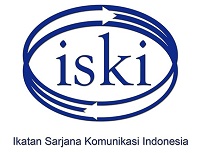Service Communication On Unisba Student Satisfaction During The Covid-19 Pandemic
Abstract
Keywords
Full Text:
PDFReferences
Adisel, A., & Prananosa, A. G. (2020). Penggunaan Teknologi Informasi dan Komunikasi dalam Sistem Manajemen Pembelajaran pada Masa Pandemi Covid 19. Journal Of Administration and Educational Management (ALIGNMENT), 3(1). https://doi.org/10.31539/alignment.v3i1.1291
Afriliana, I., Indrianto, J., & Kusuma, A. C. (2021). Pemanfaatan Teknologi Informasi guna Peningkatan Kemampuan Pendidik untuk Model Pembelajaran Jarak Jauh. 10(02), 266–274. https://doi.org/https://doi.org/10.22236/solma.v10i2.6510
Bajari, A. (2015). Metode penelitian Komunikasi; Prosedur, Trend & Etika. Simbioasa Rekatama Media.
Bungin, B. (2017). Metode Penelitian Kuantitatif. Kencana Prenada Media Group. Jakarta.
Effendi, M. R., & Setiadi, E. (2021). Model of Development of Ruhul Islam In Bandung Islamic University. MIMBAR : Jurnal Sosial Dan Pembangunan, 37(1). https://doi.org/10.29313/mimbar.v37i1.7689
Hamidin, D. (2008). Model customer relationship management (CRM) di institusi pendidikan. Seminar Nasional Aplikasi Teknologi Informasi (SNATI) Vol.1 No.1.
Indriyani, S., & Mardiana, S. (2016). Pengaruh Penanganan Keluhan (Complaint Handling) Terhadap Kepercayaan Dan Komitmen Mahasiswa Pada Perguruan Tinggi Swasta Di Bandar Lampung. Jurnal Bisnis Darmajaya, 2(1), 1–13.
Kasmir. (2017). Customer Service Excellent : Teori dan Praktik. PT Rajagrafindo Persada.
Kriyantono, R. (2014). Teori public relations perspektif barat dan lokal: Aplikasi penelitian dan praktik. Kencana.
Madiawati, P. N., Pradana, M., & Sulistijono, S. (2020). The Importance of Organizational Commitments and Performance: Studies of Corporate University in West Java. MIMBAR : Jurnal Sosial Dan Pembangunan, 36(2). https://doi.org/10.29313/mimbar.v36i2.5941
Rustanta, A., & Setyawati, K. (2019). Hubungan Layanan Komunikasi terhadap Kepuasan Mahasiswa. Jurnal Ilmu Komunikasi Dan Bisnis , 4(2).
Saleh, A. M. (2010). Public Service Communication. Universitas Muhammadiyah Malang.
Sampurno, M. B. T., Kusumandyoko, T. C., & Islam, M. A. (2020). Budaya Media Sosial, Edukasi Masyarakat, dan Pandemi COVID-19. SALAM: Jurnal Sosial Dan Budaya Syar-I, 7(5). https://doi.org/10.15408/sjsbs.v7i5.15210
Sara, K., Witi, F. L., & Mude, A. (2020). Implementasi E-Learning Berbasis Moodle di Masa Pandemi Covid 19. Journal Of Administration and Educational Management (ALIGNMENT), 3(2). https://doi.org/10.31539/alignment.v3i2.1813
Suryana, A., Zein, D., Sumartias, S., & Gemiharto, I. (2019). Pengaruh Strategi Komunikasi Pemasaran, Budaya Organisasi, Karakteristik Individu Inovatif Dan Komitmen Organisasional Terhadap Kinerja Usaha Kecil Dan Menengah. Jurnal Manajemen Komunikasi, 3(2). https://doi.org/10.24198/jmk.v3i2.20754
Tjia, M., & Fitriani, D. R. (2019). Pengaruh Motif Selfie Terhadap Keterbukaan Diri Generasi Milenial. Mediator: Jurnal Komunikasi, 12(2). https://doi.org/10.29313/mediator.v12i2.5037
Trimanah, T., & Wulandari, D. (2018). Prinsip Public Relations dalam Ajaran Islam Menurut Persepsi Anggota Perhumas Jawa Tengah. Mediator: Jurnal Komunikasi, 11(1). https://doi.org/10.29313/mediator.v11i1.3171
Wiwitan, T., & Yulianita, N. (2017). Strategi Marketing Public Relations Perguruan Tinggi Islam Swasta: Peluang dan Tantangan di Era MEA. Mediator: Jurnal Komunikasi, 10(1). https://doi.org/10.29313/mediator.v10i1.2672
Wuri, J. (2021). Kinerja Pegawai Dalam Pelayanan Publik Di Era Covid-19 (Studi Di Kecamatan Langowan Barat Kabupaten Minahasa). Jurnal Politico, 21(1).
Zainuri, A. (2018). Media Pembelajaran dalam Pandangan Islam. Medina-Te : Jurnal Studi Islam, 14(1), 1–17. https://doi.org/10.19109/medinate.v14i1.2351
DOI: https://doi.org/10.29313/mediator.v14i2.8327
Refbacks
- There are currently no refbacks.

This work is licensed under a Creative Commons Attribution 4.0 International License























